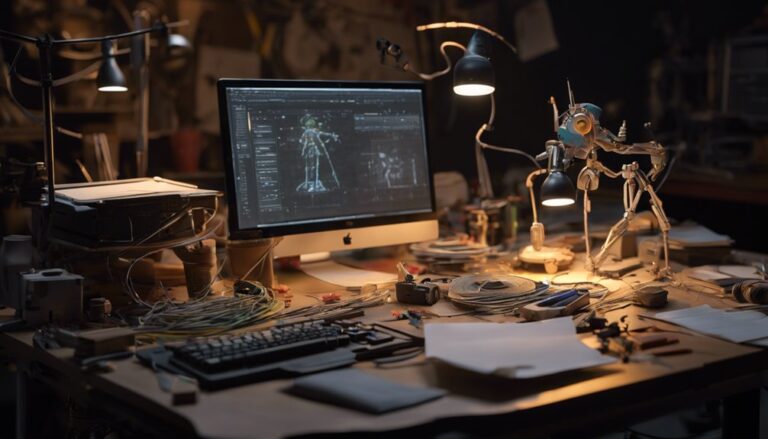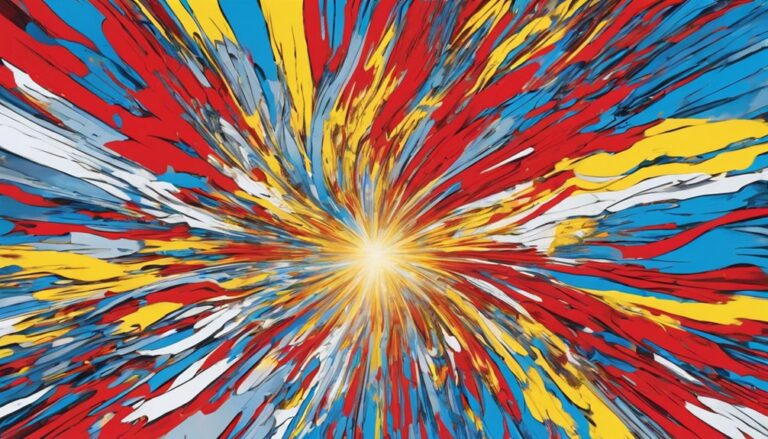Top Digital Animation Tools for Visual Effects
As you venture into the world of digital animation, you'll soon realize that having the right tools is vital to bringing your creative vision to life. You've probably heard of industry giants like Autodesk Maya and Nuke, but what about the lesser-known powerhouses like Blender and Houdini? With so many options available, it can be overwhelming to choose the best fit for your project. But what if you could reveal the secrets of these top digital animation tools and take your visual effects to the next level? Let's explore the top tools that'll help you achieve stunning results.
Key Takeaways
- Autodesk Maya is a powerful 3D computer animation software used in nearly every professional studio.
- Blender is a free animation software that rivals paid counterparts with advanced modeling, rigging, and rendering tools.
- Nuke and Blackmagic Design Fusion are industry-standard compositing tools for visual effects and motion graphics.
- Adobe Animate and Toon Boom Harmony are top choices for 2D animation, offering robust features and intuitive interfaces.
Autodesk Maya for 3D Animation
You'll likely encounter Autodesk Maya, a powerful 3D computer animation, modeling, simulation, and rendering software, in nearly every professional 3D animation studio.
As a digital animator, you'll need to master Maya to stay competitive in the industry. To get started, you can take advantage of numerous Maya tutorials available online, which cover everything from basic modeling techniques to advanced character rigging.
These tutorials will help you develop the skills you need to create stunning visual effects.
To demonstrate your expertise, consider obtaining Maya certification. This prestigious certification is recognized industry-wide and can substantially boost your career prospects.
With Maya certification, you'll be able to showcase your skills to potential employers and clients, giving you a competitive edge in the job market.
Blender for Free Animation Software
As you explore Blender as a free animation software, you'll discover a powerful toolset that rivals its paid counterparts.
You'll have access to a range of key features that simplify your workflow, including advanced 3D modeling capabilities and robust rendering and lighting options.
Blender's Key Features
Blender's extensive feature set, which is completely free to use, includes a powerful modeling system, advanced rigging and animation tools, and a built-in rendering engine, making it an ideal choice for animators and artists.
As you plunge into Blender, you'll find that it's packed with features that cater to both beginners and pros. You can start with Blender basics, such as understanding the interface and navigation, and then move on to advanced techniques through Blender tutorials.
The software's node-based compositor allows you to create complex compositions and effects, while its physics engine simulates real-world phenomena like smoke, fire, and water.
You can also take advantage of Blender's advanced animation tools, including keyframe animation, path animation, and physics-based animation.
Additionally, the software's built-in rendering engine, Cycles, offers stunning realism and flexibility.
With Blender, you can create stunning visuals without breaking the bank.
3D Modeling Capabilities
With its robust 3D modeling capabilities, Blender empowers artists to craft intricate characters, props, and environments, allowing for precise control over geometry, topology, and surface details.
You'll have the freedom to experiment with various modeling techniques, from polygon modeling to 3D sculpting, to achieve the desired look for your project.
The software's advanced tools, such as extrusions, sweeps, and lofts, enable you to create complex shapes and structures with ease.
Additionally, Blender's mesh editing features, including edge and face manipulation, allow for detailed refinement of your models.
When working on organic shapes, you'll appreciate Blender's 3D sculpting tools, which mimic traditional clay sculpting techniques.
The software's dynamic topology and remeshing features guarantee that your models remain efficient and optimized, even when working with high-poly counts.
As you refine your models, Blender's real-time feedback and precision control enable you to achieve the level of detail and accuracy required for professional-level visual effects.
Whether you're creating realistic characters, fantastical creatures, or futuristic environments, Blender's 3D modeling capabilities provide the flexibility and power you need to bring your vision to life.
Rendering and Lighting
You step into the virtual cinematographer's role, harnessing Blender's rendering and lighting capabilities to breathe life into your 3D models, transforming them into cinematic masterpieces. As you navigate the domain of rendering, you'll discover the power of real-time rendering, allowing you to preview your work instantly and make adjustments on the fly. This feature enables you to experiment with different lighting setups, camera angles, and material properties, ensuring your vision takes shape swiftly.
| Lighting Technique | Description | Blender Feature |
|---|---|---|
| Ambient Occlusion | Simulates soft, indirect lighting | Ambient Occlusion Pass |
| Volumetric Lighting | Creates realistic, 3D lighting effects | Volumetric Lighting Option |
| Global Illumination | Calculates accurate, indirect lighting | Global Illumination Solver |
| Ray Tracing | Produces photorealistic reflections and refractions | Cycles Ray Tracing Engine |
With Blender's robust rendering and lighting tools, you can craft immersive environments, from ethereal landscapes to gritty, urban scenes. By mastering these techniques, you'll access the full potential of your 3D creations, transporting your audience to new and exciting worlds.
Nuke for Compositing and Editing
When you're working on a complex visual effects project, you'll appreciate Nuke's node-based compositing system, which allows you to create and manage intricate node graphs with ease.
This flexible system enables you to build and modify your composites quickly, making it an ideal tool for fast-paced production environments.
You'll also benefit from Nuke's advanced 3D tracking capabilities, which help you accurately track and replicate real-world camera movements.
Node-Based Compositing System
Nuke's node-based compositing system revolutionizes the visual effects pipeline by allowing artists to create complex composites through a flexible, modular, and highly customizable workflow.
As you plunge into Nuke's node-based system, you'll discover a world of creative possibilities. You can build complex compositing workflows by connecting nodes, each representing a specific operation or effect.
This visual scripting approach enables you to focus on the creative aspects of your project, rather than getting bogged down in code.
You can create intricate composites by combining multiple nodes, adjusting parameters, and tweaking settings to achieve the desired look.
Nuke's node-based system also allows for easy experimentation and iteration, making it an ideal tool for exploring different creative directions.
With Nuke, you can effortlessly manage complex compositing workflows, making it an essential tool for visual effects artists and studios.
Advanced 3D Tracking
Building on the flexibility of Nuke's node-based compositing system, advanced 3D tracking capabilities take your visual effects to the next level, allowing for seamless integration of 3D elements into live-action footage. You'll be able to accurately track camera movements and object placement, ensuring a realistic and immersive experience for your audience.
Camera calibration: automatically estimates camera parameters, including focal length, aperture, and sensor size, for precise tracking
Object placement: allows you to place 3D objects directly into your scene, with accurate tracking and orientation
Planar tracking: tracks flat surfaces, such as walls or floors, for precise placement of 2D or 3D elements
Mesh tracking: tracks complex 3D objects, including characters and vehicles, for realistic interactions
Solver-based tracking: uses advanced algorithms to solve complex tracking problems, ensuring accurate results even in challenging scenarios
With these advanced 3D tracking features, you'll be able to push the boundaries of visual effects and create stunning, realistic environments that will leave your audience in awe.
Adobe Animate for 2D Animation
With its robust set of features and intuitive interface, Adobe Animate has established itself as a go-to tool for creating engaging 2D animations that bring your creative vision to life.
As you plunge into this powerful software, you'll appreciate the frequent Adobe updates that continually expand its capabilities. For instance, the latest updates have introduced advanced animation techniques, such as tweening and easing, which allow you to create more realistic and nuanced movements.
You'll also appreciate the vector-based graphics, which enable you to scale your designs without sacrificing quality.
To take your animations to the next level, you can experiment with Adobe Animate's advanced features, such as layer blending modes and advanced color management. These tools will give you the precision and control you need to craft stunning 2D animations that captivate your audience.
Houdini for Dynamic Simulations
As you venture into the domain of dynamic simulations, Houdini empowers you to craft intricate, realistic environments and special effects that transport your audience to new worlds.
With its robust toolset, you can create complex simulations that mimic real-world phenomena, from turbulent water to explosive destruction.
Houdini's dynamic simulations offer unparalleled control and flexibility.
You can create realistic Dynamic Fluids with precise control over viscosity, surface tension, and density.
You can design intricate Simulation Workflows that integrate seamlessly with your existing pipeline.
You can use procedural modeling to generate complex geometries and environments.
You can leverage Houdini's powerful solver to simulate everything from rigid body dynamics to soft body simulations.
You can export your simulations as alembic caches or direct-to-render assets for maximum efficiency.
Blackmagic Design Fusion
You step into the world of node-based compositing with Blackmagic Design Fusion, where you'll harness the power of a robust visual effects system to craft stunning, high-end visuals.
This industry-standard tool lets you create complex composites with ease, thanks to its intuitive visual workflow. You'll work with a flowchart-like interface, where nodes represent individual elements, and connections define how they interact.
This visual approach makes it easy to manage complex node hierarchies and experiment with different effects.
As you excavate further, you'll appreciate Fusion's advanced node management capabilities.
You can create custom nodes, reuse existing ones, and even build complex macros. This flexibility allows you to focus on the creative aspects of your project, rather than getting bogged down in technical details.
With Fusion, you can effortlessly combine 2D and 3D elements, perform advanced color grading, and add realistic motion blur.
The result? Photorealistic visuals that transport your audience to new worlds.
Side Effects Houdini Engine
This powerful 3D animation software releases the full potential of procedural modeling, allowing designers to create intricate, realistic models and animations with unprecedented speed and flexibility.
With Houdini Engine, you'll be able to harness the power of procedural modeling to generate complex models, animations, and visual effects that would be impossible to achieve by hand.
Unparalleled flexibility: Create complex models and animations that can be easily modified and updated.
Lightning-fast rendering: Houdini Engine's powerful rendering engine allows for fast and efficient rendering of even the most complex scenes.
Seamless integration: Easily integrate Houdini Engine with other tools and software in your pipeline.
Endless possibilities: With Houdini Engine, the possibilities are truly endless – from realistic water simulations to intricate character animations.
Access to a wealth of resources: Take advantage of a vast library of Houdini tutorials and online resources to help you get started and improve your skills.
Whether you're a seasoned pro or just starting out, Houdini Engine is the perfect tool for tapping the full potential of procedural modeling and taking your visual effects to the next level.
Toon Boom Harmony for Animation
Harnessing the power of vector-based animation, Toon Boom Harmony empowers artists to create complex, stylized, and engaging animations with precision and control. With a rich history dating back to 1990, Toon Boom has established itself as a leading provider of animation software, used by top studios like Disney, Warner Bros., and Pixar. As you explore into Harmony, you'll discover a robust toolset that streamlines your workflow and brings your creative vision to life.
| Feature | Description |
|---|---|
| Vector-based animation | Create complex shapes and movements with ease |
| Node-based compositing | Combine multiple elements into a single scene |
| Advanced tweening | Achieve precise control over animation timing and spacing |
| Deformation tools | Add realistic texture and movement to your characters |
| Harmony Tutorials | Access a wealth of online resources to master the software |
Toon Boom Harmony offers a wide range of features that cater to both beginners and seasoned professionals. By leveraging its powerful tools and intuitive interface, you'll be able to produce high-quality animations that captivate your audience. Whether you're working on a TV series, film, or commercial, Harmony provides the flexibility and precision you need to bring your vision to life.
Frequently Asked Questions
Can I Use Digital Animation Tools for Live-Action Film Visual Effects?
You can definitely use digital animation tools for live-action film visual effects, seamlessly integrating CGI elements into your footage while meeting film industry standards, and achieving photorealistic live action integration that wows your audience.
Are Digital Animation Tools Compatible With Mac and PC Operating Systems?
You'll be relieved to know that most digital tools are designed with cross-platform compatibility in mind, ensuring seamless operation on both Mac and PC, as long as you meet the system requirements, of course.
Do I Need Coding Skills to Use Digital Animation Tools Effectively?
You don't necessarily need coding skills to bring your artistic vision to life, as many digital animation tools offer intuitive interfaces that preserve your creative freedom, allowing you to focus on storytelling and visual design.
Can I Collaborate With Others in Real-Time Using Digital Animation Tools?
You can seamlessly collaborate with others in real-time using cloud-based workflows, receiving instantaneous feedback and iterating together on projects, thanks to the latest digital animation tools that facilitate efficient remote teamwork.
Are Digital Animation Tools Suitable for Creating Video Game Animations?
You're wondering if digital animation tools are suitable for creating video game animations. Absolutely, they're ideal for game development, as they streamline animation pipelines, allowing you to efficiently create engaging in-game animations that elevate player experiences.
Conclusion
You've got the power to create stunning visual effects and animations at your fingertips.
With industry-standard tools like Autodesk Maya, Blender, and Nuke, you can bring your vision to life.
From 2D animation with Adobe Animate and Toon Boom Harmony, to dynamic simulations with Houdini and Side Effects Houdini Engine, the possibilities are endless.
And with Blackmagic Design Fusion, you can composite and edit like a pro.
Liberate your creativity and take your visual effects to the next level!







